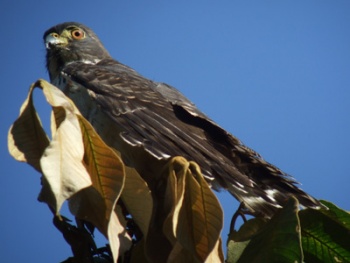(→References: Updated and expanded) |
(→Behaviour: Added breeding and voice sections, expanded diet.) |
||
| Line 31: | Line 31: | ||
Lowland rainforest, forest edge and secondary-growth woodland. | Lowland rainforest, forest edge and secondary-growth woodland. | ||
==Behaviour== | ==Behaviour== | ||
| + | ====Breeding==== | ||
| + | The nest is a shallow cup of twigs placed high in the fork of a tree, usually at the forest edge. Clutch size is 1-2 eggs, which are white with brown markings. The female conducts most of the nest building, all of the incubation duties, and brooding and most of the feeding of the young. The male does most of the hunting and provides the majority of prey to the female. Incubation is usually 42-45 days with the nestling period from 27-37 days. The young are dependent upon the parents for at least two months, sometimes longer | ||
====Diet==== | ====Diet==== | ||
| − | + | Feeds mostly on lizards and insects (including butterflies) and rarely on birds, nestling birds, bats, snakes, and rats. In some parts of its range it follows troops of monkeys catching prey they flush. | |
| + | ====Vocalisations==== | ||
| + | Usually silent except during the nesting season which it gives a series of high calls like some flycatchers:'' tsip-tsip-tsip.'' | ||
| + | |||
==References== | ==References== | ||
#{{Ref-Clements6thAug18}}#[http://www.birdforum.net/showthread.php?p=1837629 Birdforum thread] discussing this species | #{{Ref-Clements6thAug18}}#[http://www.birdforum.net/showthread.php?p=1837629 Birdforum thread] discussing this species | ||
Revision as of 22:08, 31 December 2018
- Harpagus bidentatus
Identification
34cm.
- Grey head
- White throat which has a dark central stripe (except in darkest individuals where throat is dark)
- Rufous breast band
- Lower breast barred
- Dark tail, tipped white and with 3 whitish bands
- Red iris (in the southern and south-eastern part of its range, some birds have yellow iris!)
- Yellow legs
- Two horny teeth on the cutting edges of the upper mandible
Similar Species
Roadside Hawk has yellow eyes and lack the dark central throat stripe
Distribution
Central and South America.
Breeds in Guerrero, Veracruz and Oaxaca in southern Mexico and through Central America from Guatemala to Panama. In South America breeds from Colombia, Venezuela and Trinidad south to Peru, Bolivia and southern Brazil.
Resident.
Taxonomy
Subspecies
There are 2 subspecies[1]:
- H. b. fasciatus:
- H. b. bidentatus:
Habitat
Lowland rainforest, forest edge and secondary-growth woodland.
Behaviour
Breeding
The nest is a shallow cup of twigs placed high in the fork of a tree, usually at the forest edge. Clutch size is 1-2 eggs, which are white with brown markings. The female conducts most of the nest building, all of the incubation duties, and brooding and most of the feeding of the young. The male does most of the hunting and provides the majority of prey to the female. Incubation is usually 42-45 days with the nestling period from 27-37 days. The young are dependent upon the parents for at least two months, sometimes longer
Diet
Feeds mostly on lizards and insects (including butterflies) and rarely on birds, nestling birds, bats, snakes, and rats. In some parts of its range it follows troops of monkeys catching prey they flush.
Vocalisations
Usually silent except during the nesting season which it gives a series of high calls like some flycatchers: tsip-tsip-tsip.
References
- Clements, J. F., T. S. Schulenberg, M. J. Iliff, D. Roberson, T. A. Fredericks, B. L. Sullivan, and C. L. Wood. 2018. The eBird/Clements checklist of birds of the world: v2018. Downloaded from http://www.birds.cornell.edu/clementschecklist/download/
- Birdforum thread discussing this species
- Arthur Grosset
- Bierregaard, R.O., Jr, Marks, J.S. & Kirwan, G.M. (2018). Double-toothed Kite (Harpagus bidentatus). In: del Hoyo, J., Elliott, A., Sargatal, J., Christie, D.A. & de Juana, E. (eds.). Handbook of the Birds of the World Alive. Lynx Edicions, Barcelona. (retrieved from https://www.hbw.com/node/52973 on 31 December 2018).
- Double-toothed Kite (Harpagus bidentatus), In Neotropical Birds Online (T. S. Schulenberg, Editor). Cornell Lab of Ornithology, Ithaca, NY, USA. retrieved from Neotropical Birds Online: https://neotropical.birds.cornell.edu/Species-Account/nb/species/dotkit1
Recommended Citation
- BirdForum Opus contributors. (2024) Double-toothed Kite. In: BirdForum, the forum for wild birds and birding. Retrieved 28 May 2024 from https://www.birdforum.net/opus/Double-toothed_Kite






